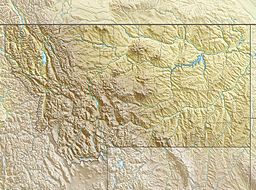Shaheeya Peak facts for kids
Quick facts for kids Shaheeya Peak |
|
|---|---|
| Highest point | |
| Elevation | 8,052 ft (2,454 m) |
| Prominence | 692 ft (211 m) |
| Geography | |
| Location | Glacier County, Montana, U.S. |
| Parent range | Livingston Range |
| Topo map | USGS Porcupine Ridge, MT |
Shaheeya Peak is a mountain located in the Livingston Range, a part of the amazing Glacier National Park in the state of Montana, U.S.. This peak stands tall at 8,052 feet (2,454 m)! Close by, you'll find Shaheeya Lake just to the east and Wahseeja Lake to the northwest. This area is famous for its incredible natural beauty and wild animals.
Contents
Discovering Shaheeya Peak
Shaheeya Peak is a mountain that reaches high into the sky. It's a part of the beautiful Livingston Range, which is a mountain chain. Imagine a giant's playground filled with tall peaks and deep valleys. That's a bit like the Livingston Range!
Where is Shaheeya Peak Located?
Shaheeya Peak is found in Glacier National Park. This park is in the state of Montana, which is in the northwestern part of the U.S.. Montana is known for its big skies and wide-open spaces. The park itself is right on the border with Canada.
Glacier National Park: A Special Place
Glacier National Park is often called the "Crown of the Continent." This is because it has stunning mountains, clear lakes, and ancient forests. It's a very important place for nature. The park gets its name from the huge glaciers that shaped the land long ago. While most of those big glaciers are gone, the park still has a few smaller ones.
How Tall is Shaheeya Peak?
Shaheeya Peak is 8,052 feet (2,454 m) high. To give you an idea, that's taller than many famous buildings! Mountains are measured from sea level, which is the average level of the ocean's surface. So, when we say 8,052 feet, that's how far up it is from the sea.
Lakes Near Shaheeya Peak
There are two beautiful lakes very close to Shaheeya Peak.
- Shaheeya Lake is located just to the east of the peak.
- Wahseeja Lake is found to the northwest.
These lakes are often fed by melting snow and ice from the mountains. They are usually very clear and cold.
Wildlife and Nature Around Shaheeya Peak
The area around Shaheeya Peak, within Glacier National Park, is home to many different kinds of plants and animals. It's a wild place where nature thrives.
Animals of the Livingston Range
You might see some amazing animals living near Shaheeya Peak.
- Bears: Both grizzly bears and black bears live in the park. They are very important to the ecosystem.
- Mountain Goats: These amazing animals are often seen climbing steep, rocky slopes. They are very good at living in high mountain areas.
- Borns: You might also spot bighorn sheep, which have huge, curled horns.
- Elk and Deer: Large herds of elk and different types of deer roam the forests and meadows.
- Birds: Many birds, like bald eagles and osprey, fly over the lakes and mountains.
Plants and Trees
The slopes of Shaheeya Peak and the valleys around it are covered with different types of plants.
- Forests: You'll find thick forests of conifer trees, like Douglas fir and lodgepole pine. These trees stay green all year round.
- Wildflowers: In the spring and summer, the meadows burst with colorful wildflowers. These flowers add bright splashes of color to the green landscape.
How Mountains Like Shaheeya Peak Formed
Mountains like Shaheeya Peak didn't just pop up overnight! They were formed over millions of years by powerful forces deep within the Earth.
Earth's Moving Plates
The Earth's outer layer is made up of huge pieces called tectonic plates. These plates are always slowly moving, like giant rafts on a liquid layer. When these plates push against each other, they can cause the land to fold, crack, and lift upwards.
Uplift and Erosion
The mountains in the Livingston Range were formed when these plates pushed together, causing the land to be uplifted. Imagine pushing a rug from both ends – it wrinkles up! That's a bit like how mountains form. Over long periods, wind, water, and ice also wear away at the mountains, shaping them into the peaks and valleys we see today. This process is called erosion.



